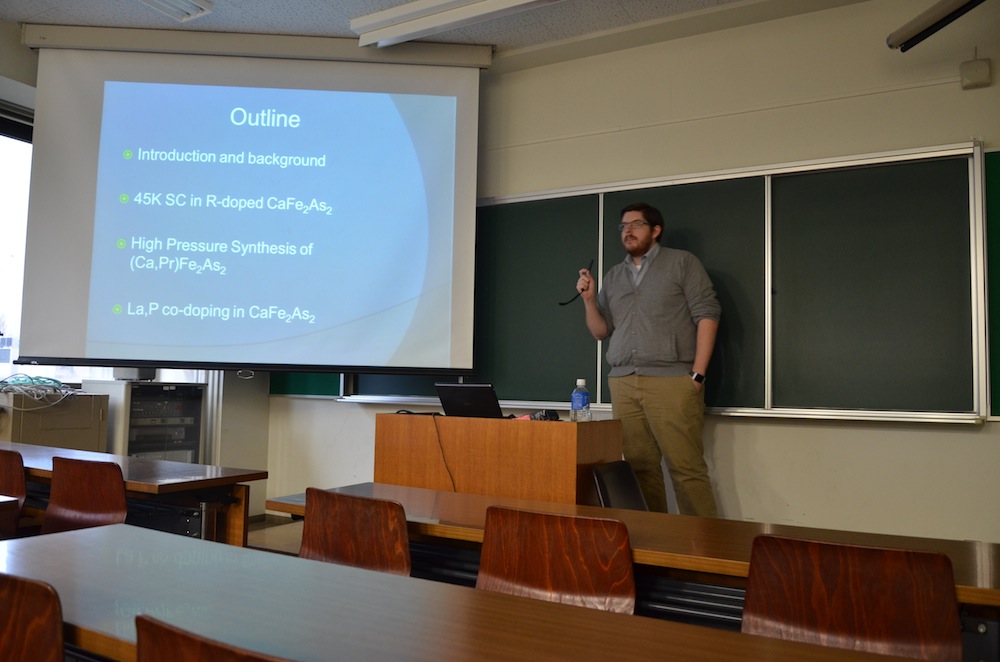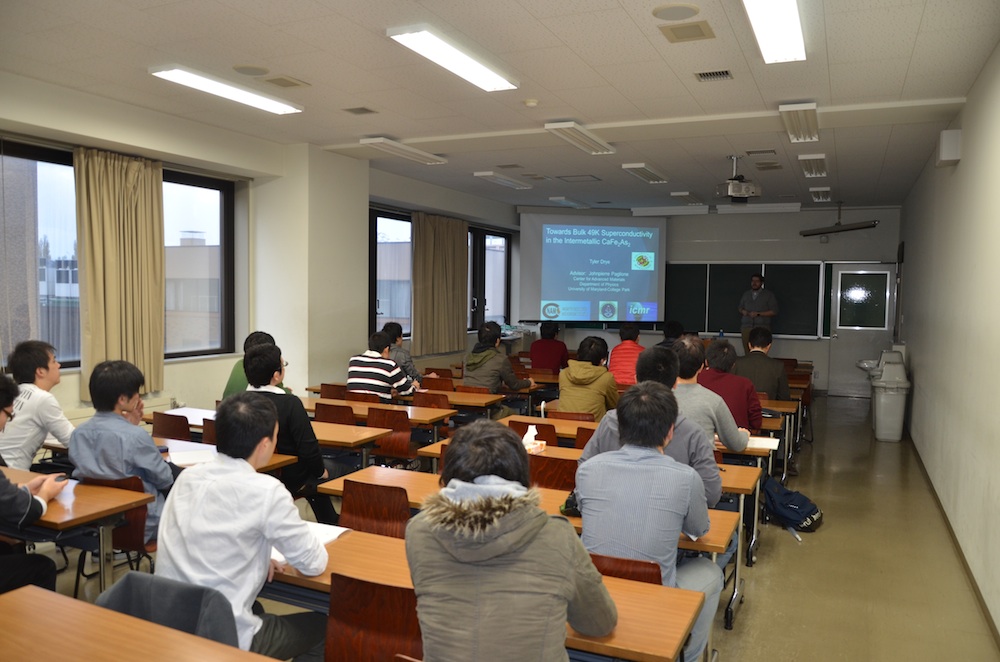日本物理学会北海道支部 講演会
講演会のアナウンスは支部会員のメーリングリストで行われます。 支部講演会・共催の講演会のお申し込みは、支部役員までご連絡下さい。
支部講演会の過去ログは、右バナーのArchivesからご覧ください。
最近5回分の講演リストを以下に表示します。
2024/12/13 「強磁場量子極限下のトポロジカル半金属における量子化熱電ホール効果の探索」
長田 俊人 氏
2024/11/26 「光の量子性を用いた計測技術」
岡本 亮 氏
2024/10/11 「Specifics of spin excitations in centrosymmetric helimagnets」
Dmytro S. Inosov 氏
2024/09/13 「磁場角度分解熱物性測定の高度化と物性研究への応用」
橘高 俊一郎 氏
2024/08/27 「μSRと第一原理計算で迫る銅酸化物高温超伝導体の電子スピン状態」
渡邊 功雄 氏
長田 俊人 氏
2024/11/26 「光の量子性を用いた計測技術」
岡本 亮 氏
2024/10/11 「Specifics of spin excitations in centrosymmetric helimagnets」
Dmytro S. Inosov 氏
2024/09/13 「磁場角度分解熱物性測定の高度化と物性研究への応用」
橘高 俊一郎 氏
2024/08/27 「μSRと第一原理計算で迫る銅酸化物高温超伝導体の電子スピン状態」
渡邊 功雄 氏
「遍歴電子系における特異な磁性と電子状態 - 多重Q秩序、ディラック電子、磁気的なトポロジカル絶縁体 -」
速水 賢 氏
Oct 28, 2014
日本物理学会北海道支部講演会
講演題目: 遍歴電子系における特異な磁性と電子状態 - 多重Q秩序、ディラック電子、磁気的なトポロジカル絶縁体 -
講 師 : 速水 賢 博士
東京大学大学院工学系物理工学専攻
日 時 : 平成26年10月28日 (火) 17:00-18:00
場 所 : 北海道大学理学部5号館205室(5-2-05)
要 旨 :
スピンが互いに平行でない非共線や非共面的な磁気構造は、遍歴電子との結合を 通じて、異常ホール効果やスピンホール効果といった非従来型の輸送現象をもた らすことから注目を集めている。 本講演では、こうした遍歴磁性体における特異な磁性の新しい安定化機構、 およびそのもとで生じる新しい電子状態に関する我々の研究成果を紹介する。 我々が今回提案する多重Q磁気構造の新しい安定化機構は、フェルミ面の形状に 起因したもので、格子の空間次元や構造によらない普遍的なものである。 さらに、こうして現れる多重Q磁気秩序が、ディラック半金属やトポロジカル絶 縁体といった、トポロジカルに非自明な電子状態をもたらすことも議論する。
世話人 網塚浩
(amiami@phys.sci.hokudai.ac.jp)
北海道大学理学部物理学科 (電話011-706-3484)
"Hybrid ferromagnetic-superconductor nanosystems"
Prof. Sergei P. Kruchinin
Oct 16, 2014
物理学会北海道支部講演会(第204回エンレイソウの会との共催)
講演題目: Hybrid ferromagnetic-superconductor nanosystems
講 師 : Prof. Sergei P. Kruchinin
Bogolyubov Institute for Theoretical Physics, Ukraine
日 時 : 平成26年10月16日 (火) 16:30-18:00
場 所 : 北海道大学工学部A棟A1-17
要 旨 :
Recent advances in nanoscience have demonstrated that fundamentally new physical phenomena are found, when systems are reduced in size to dimensions that become comparable to the fundamental microscopic length scales of a material under study. Superconductivity is a macroscopic quantum phenomenon, and therefore it is of particular interest to see how this quantum state is influenced when the samples are reduced to nanometer sizes. Nowadays, developments in nanotechnologies and measurement techniques allow the experimental investigation of the magnetic and thermodynamic superconducting properties of mesoscopic samples in this regime. In this lecture, we will present theoretical models to describe such nanoscale superconducting systems and discuss possible new experimental phenomena we can predict within these theoretical models. We will consider the theory of interactions between two nanoscale ferromagnetic particles embedded in a superconductor. In the London limit approximation, we show that the interactions between ferromagnetic particles can lead to either parallel or antiparallel spin alignment. The crossover between those is dependent on the ratio of the interparticle spacing and the London penetration depth. We will show that a phase transition between spin orientations can occur as the temperature is varied. Finally, we comment on the extension of these results to arrays of nanoparticles in different geometries. In view of modern experimental data, we consider also composite nanowires made from both superconducting and ferromagnetic metals in the case of cylindrical geometry, where one metal forms the core of a nanowire, and the second forms an outer cylindrical sheath. Moreover, we analyze also the inverse situation, in which a normal or ferromagnetic core is surrounded by a superconducting sheath. In this case, it is interesting to examine the spectrum of Andreev bound states in the normal or ferromagnetic core.
世話人 浅野 泰寛
(asano@eng.hokudai.ac.jp)
北海道大学大学院工学研究院応用物理学部門
"Dynamic Effects of Broken Parity in Chiral and Octupolar Phases"
Prof. Dr. Helmut R. Brand
Sep 16, 2014
日本物理学会北海道支部講演会
トポロジー理工学教育研究センター第203回エンレイソウの会
物理コロキウム共催
講演題目: Dynamic Effects of Broken Parity in Chiral and Octupolar Phases
講 師 : Prof. Dr. Helmut R. Brand
Theoretical Physics III, Bayreuth University, Germany
日 時 : 平成26年9月16日 (火) 13:00-14:00
場 所 : 北海道大学理学部2号館211室(2-2-11)
要 旨 :
We analyze dynamic effects of broken parity in various liquid crystalline phases. Topics covered include Lehmann-type effects as well as inverse Lehmann-type effects, which can be used as a microscopic pump [1]. Recently we have demonstrated that such effects can also arise in liquid crystalline systems made of achiral molecules provided the overall structure has macroscopic chirality [2]. In such a situation we predict that Lehmann-type effects as well as rotatoelectricity are possible [2].
Over the last few years it has become clear that octupolar (tetrahedral) order could come into play for various types of nematic liquid crystal phases. We investigate the resulting macroscopic behavior of non-polar tetrahedral nematic liquid crystals [3,4] and discuss ambidextrous chirality versus ambidextrous helicity for nonpolar nematic phases of sufficiently low symmetry [5].
Using these results we make contact with selected recent experimental results. For Lehmann-type effects we analyze experimental results on free-standing chiral smectic films [6]. We also critically compare our analysis with reports of octupolar nematic order in at least two different systems [7,8]. Quite remarkably previous experiments also indicate the presence of octupolar order [9,10].
[1] D. Svensek, H. Pleiner, and H.R. Brand, Phys. Rev. E 78, 021703
(2008). [2] H.R. Brand, H. Pleiner, and D. Svensek, Phys. Rev. E 88, 024501 (2013).
[3] H.R. Brand, H. Pleiner and P.E. Cladis, Physica 351, 189 (2005).
[4] H.R. Brand and H. Pleiner, Eur. Phys. J. E 31, 37 (2010).
[5] H. Pleiner and H.R. Brand, Eur. Phys. J. E 37, 11 (2014).
[6] K. Seki, K. Ueda, Y. Okumura, and Y. Tabe, J. Phys. Cond. Matt. 23, 284114 (2011).
[7] E.H. Kim, O.N. Kadkin, S.Y. Kim, and M.-G. Choi, Eur. J. Inorg. Chem. 2011, 2933 (2011).
[8] Y. Jang, R. Balachandran, C. Keith, A. Lehmann, C. Tschierske, and J.K. Vij, Soft Matter 8, 10479 (2012).
[9] W. Weissflog, M.W. Schroeder, S. Diele, and G. Pelzl, Adv. Mater. 2003. 630 (2003).
[10] G. Pelzl, A. Eremin, S. Diele, H. Kresse, and W. Weissflog, J. Mat. Chem. 12, 2591 (2002).
世話人 北孝文
(kita@phys.sci.hokudai.ac.jp)
北海道大学理学部物理学科 内線(2687)
「パリティの自発的破れがもたらす特異な電子状態」
楠瀬 博明氏
Feb 14, 2014
日本物理学会北海道支部講演会
トポロジー理工学教育研究センター第197回エンレイソウの会共催
講演題目: パリティの自発的破れがもたらす特異な電子状態
講 師 : 楠瀬 博明氏
愛媛大学大学院理工学研究科 准教授
日 時 : 平成26年2月14日 (金) 16:30-18:00
場 所 : 北海道大学理学部5号館206室(5-2-06)
要 旨 :
空間・時間反転対称性は固体中の電子状態の性質を強く制限している。 これらの自発的な破れが発生すれば、通常の磁性体のように、新しい物性を生み出すと期待される。 特に、スピン軌道相互作用がある系では、磁気と電気の間の非対角な応答が発生する。 本講演では、蜂の巣格子のような交替的に反転対称性のない系に着目して、反強磁性などの秩序が 空間反転対称性の自発的破れを誘発すること、その結果、生じる反対称スピン軌道相互作用もしくは 反対称スカラー場が電気磁気効果やスピン伝導などの非対角な応答に特異な影響を及ぼすこと、 を紹介する。特に、蜂の巣格子における2軌道ミニマル模型の解析結果を中心に議論したい。
世話人 柳澤達也
(tatsuya@phys.sci.hokudai.ac.jp)
北海道大学大学院理学研究院物理学部門
"Towards Bulk 49K Superconductivity in the Intermetallic CaFe2As2"
Mr. Tyler Drye
Nov 18, 2013
日本物理学会北海道支部講演会
トポロジー理工学教育研究センター第195回エンレイソウの会共催
講演題目: Towards Bulk 49 K Superconductivity in the Intermetallic CaFe2As2
講 師 : Mr. Tyler Drye
Department of Physics, University of Maryland College Park
(Visiting scholar by ICMR International Research Fellowship)
日 時 : 平成25年11月18日 (月) 15:00-16:00
場 所 : 北海道大学理学部2号館409室(2-4-09)
要 旨 :
The highest achievable superconducting critical temperature (Tc) in intermetallic iron-pnictide superconductors (specifically, the 122 family) was heald to be 39K when K is substituted for Ba in BaFe2As2. Our group was among the first to report traces of superconductivity in the 40-50K range when rare earth elements are doped for Ca in CaFe2As2. Unfortunately, these materials display a drastically low shielding volume fraction and correspondingly low critical current densities. Recent studies aimed at increasing this volume fraction, including high pressure synthesis and unusual doping schemes, have met with varying levels of success. This talk will detail these efforts and the outlook for bulk superconductivity in this system.
世話人 柳澤達也
(tatsuya@phys.sci.hokudai.ac.jp)
北海道大学大学院理学研究院物理学部門
 |
 |
